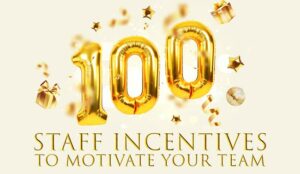We share expert advice for designing incentives for employees, sharing lots of examples along the way of how to get it right (and where it can go wrong!).
Why Aren’t Your Staff Incentives Currently Working?
Within our organizations, we have an awful lot that we do offer our people – with gift certificates, special discounts and birthday celebrations. It’s easy to reward people, right?
Well, if it is so easy, why did 2017 Gallup research suggest that only 15% of employees around the world are actively engaged with their jobs?
While there may be multiple reasons for these statistics, employee appreciation and a lack of recognition is always a key driver behind statistics like this.
Yet we have limited time, money and energy to put together a really comprehensive staff incentives programme. So we need to understand what works and what doesn’t.
What you will find is that the best incentives are those that refocus advisors back on their work, otherwise you can reinforce negative behaviours.
Tip – How Incentives Can Reinforce Negative Behaviours
The trouble with rewards is that while they can be a nice surprise at first, if they are not directly related to the job at hand, over time they will pull people’s attention away from their work. They become a distraction.

Alex Hickson
So, while there may be an increase in satisfaction and performance to begin with, over time this flatlines. But satisfaction and performance will then dip if you remove the incentive.
A classic example of staff incentives going wrong for this reason is Pizza Friday, as Alex Hickson, a contact centre gamification expert, discussed in a recent webinar with us.
A clip taken from our discussion is highlighted below.
From examples like this, we learn the importance of not letting staff incentives become repetitive and ensuring that we keep incentives linked to the work that we’re doing.
With this in mind, we need to ensure that we create the right environment for our staff incentive scheme to thrive before we introduce it. So, let’s take a look at the basics first.
For more examples of staff incentives gone wrong, read our article: Seven Examples of When Contact Centre Incentives Fail
Step 1: Get the Basics Right Before Introducing an Incentive Scheme
According to Nigel Cover, a customer experience and employee engagement consultant: “The question is often not: how do I run an incentive? but: how do I create an environment to get the best performance out of my people?”
By environment, we mean culture, and we want to design an incentive scheme that fits in with our culture. Because if we create staff incentives that are misaligned with our culture and feedback systems, we are not going to achieve the results that we anticipate.
Let’s take a look at five basics that we need to have in place before implementing an incentives scheme to help to magnify the success of our plans.
Basic No.1 – Celebrate Team Successes
This is where we can bring in pizza, cake and doughnuts – but we can’t do this all of the time, as it becomes an expectation.
This is where we can bring in pizza, cake and doughnuts – but we can’t do this all of the time, as it becomes an expectation. It needs to be linked with team success.
For example, maybe your contact centre has been through a week of chaos because the weather has caused contact volumes to rocket, but the team did a great job.
Then, out of the blue, you bring lots of cake into the office at the end of the week. The cake is no longer “just cake”. Now it is a celebration of the team’s success.
Basic No.2 – Give Regular Feedback
Do we hear about the impact that our work has on a daily basis? Likely not. But if it seems as though our work has little significance, it is hardly motivating.
So when team leaders see advisors doing positive things, are they reinforcing those behaviours with positive feedback and recognition? That can be incentive enough to reinforce the best attitudes.
Basic No.3 – Be Specific in Your Feedback
Hearing “thank you” and “good job” is nice, it feels good. But it’s not much of an incentive to repeat truly great work behaviours. After all, it’s a word that we say 50 times a day.
If we can be more specific and tell an advisor: “When you did this, the positive effect of that was…”, we can pay special attention to the values that we want to keep amongst the team.
Even if someone isn’t performing well, look for something really specific… compliment that and watch the positive impact that it starts to have on their other behaviours.
Even if someone isn’t performing well, look for something really specific, like high attendance, compliment that and watch the positive impact that it starts to have on their other behaviours.
Basic No.4 – Make Sure You Are Listening to Your Team
This doesn’t have to be through formal processes, like staff focus groups, instead we, as team leaders, can just ask open questions of advisors.
Questions regarding specific topics – not: “How good a job am I doing?” – will give you an interesting answer, but it will also show them that you respect their opinion and that it matters to you.
Basic No.5 – Ask Team Leaders to Be Careful of Their Personal Biases
We all have people that we prefer to work with over others, but it’s important that we, as leaders, don’t let that influence the time that we spend with certain individuals and the recognition that we give.
For example, we can’t praise someone for doing something which others did, but then not give that recognition to the others, just because we hadn’t spent enough time with them to see it.
Step 2: Create a Team Vision
Staff are best engaged when they feel as though they have a purpose. So wouldn’t it be great if we could create a vision with our team that creates a purpose, and then link our staff incentives scheme in with this vision? Wouldn’t that maximize engagement?
“One of the biggest motivators is being heard, and people like to have a say in what they do. If you ask people for their opinion, they feel motivated to give you an answer,” adds Nigel.

One of the biggest motivators is being heard, and people like to have a say in what they do. If you ask people for their opinion, they feel motivated to give you an answer.
So if we create a shared goal with our team, we can really engage them with what they need to do to reach that.
While we of course want our team vision to align with our organizational goals, we can come up with a mission statement such as: “To make things as easy as possible for our customers.”
By creating a statement like this, we can talk to the team about what they can do and how they can do it, so they can reach this goal – while also asking them what we can do to support them.
Step 3: Decide on How You Will Measure Your Success
The success of many inventive schemes is determined by a rise in advisor satisfaction. But just because advisors are happier at work, it doesn’t mean they are more engaged with their work. Many people will be happy if they can get away with doing as little work as possible.
Success should instead link back to our team vision, as we listen to advisors put forward their suggestions for reaching that vision. This will tell us how we can measure their success in doing so.
Then we can plot milestones for the team in reaching certain goals and targets along the way, giving them regular updates regarding their progression – to ensure that they are frequently reminded and motivated by the purpose.
Plot milestones for the team in reaching certain goals and targets along the way, giving them regular updates regarding their progression – to ensure that they are frequently reminded and motivated by the purpose.
However, we also need to be benchmarking the success of our rewards scheme against our general customer experience metrics – because we can never lose sight of the customers being our priority.
“If you understand how you are measuring the customer experience, then the customer experience becomes the stimulation for the staff incentives. There is a big link between customer experience and employee engagement,” says Nigel.
If our rewards scheme is improving advisor satisfaction but not the customer experience, either we didn’t correctly align our focus with organizational goals or our incentives are not powerful enough.
Step 4: Reward Teams and Recognize Individuals – Understand This Thinking
So far, aside from our basics given in Step 1, we’ve focused on everything from a team perspective – there is a reason for this.
The reason starts with a fundamental principle of staff incentives that we want to refocus people back on their work and align everyone behind a shared vision. This helps them to become more self-aware of their attitude and behaviours within the workplace.

Nigel Cover
If we want an incentive scheme to work over a long period of time, it must have a purpose and a vision like this.
As Nigel says: “It’s all about rewarding performance and recognizing excellence. We want to reward teams, to create harmony and a sense of belonging, and we also need to consider which moments we can recognize as excellent.”
So, let’s think of this principle as we reflect on our vision and the goals that we have set in line with that. On our way to reaching these goals, what can we do to formally recognize individuals for a great contribution and which team milestones can we reward?
This thinking is central to the creation of a great staff incentives scheme.
Step 5: Plan Formal Ways to Recognize Individuals
In Step 1, we talked a lot about creating a culture in which an incentive scheme can thrive.
When discussing this, we recommended lots of advice for giving feedback when recognizing great performance. Remember this and apply these principles to the three examples below.
These three examples can fit into your staff incentive strategy, linking each one to the vision that you created.
Recognition Incentive Example 1 – Development Opportunities

When we are specific in giving feedback, our team leaders will really start to notice the individual strengths within the team.
With this information, we can then give individual advisors a specific role to help us meet this vision – which can be particularly great when working with an advisor who is motivated by progressing in their career.
For example, if one advisor is great at building friendships amongst the team, why not make them a liaison with other departments that will help us build the relationships that will help us to reach our team goals?
By using roles like this, we can show that we not only recognize advisor strengths, we also value them and, if they prove successful, we can later reward them with a career progression opportunity incentive.
Recognition Incentive Example 2 – Most Improved Recognition

We want to ensure that, as leaders, we treat every member of the team as equal and to make an effort to recognize at least one great behaviour of some of our lower-performing advisors.
If these low-performing advisors think of themselves as “low performers”, those negative thoughts are going to bleed into their other behaviours.
“Some contact centres use leaderboards to reward staff, but being near the bottom of that leaderboard, day in, day out, must be so demotivating,” adds Nigel.
“This is why you need to mix up how your team earn incentives and this is when you bring in awards like ‘most improved team member’.”
Just don’t rely on your own opinions – which, as a human being, will likely be biased towards certain individuals – but use your data to recognize positive traits and praise them. Let that positivity spread!
Recognition Example 3 – Recognize and Celebrate Work Anniversaries

When an employee has a milestone anniversary with you – after five or ten years maybe – give them a personalized gift, not just a template certificate with their name on left at their desk.
However, if you got the team to gather around as you present the employee with the certificate, designed specially by a creative member of the team, doesn’t that certificate now mean so much more?
Just be sincere and don’t throw away such golden opportunities or simply throw money at the problem – it won’t necessarily mean so much.
Tip – Recognize Personal Preferences
Looking for opportunities for individual recognition is great, but we do need to understand that different people like to be incentivized in different ways.
“If you are going to recognize someone, you have to understand whether or not that person wants to be recognized publicly or privately,” says Nigel.
“There are some people who want the whole world to know how brilliant they are, while there are others who like to have a thank you from the boss quietly and get on with their work.”
This again goes back to the basics that we put forward in Step 1. If you and your team leaders don’t understand simple individual preferences like this, you are not going to be able to design an incentives scheme that receives contact centre-wide acclaim.
For more advice for further developing team leaders, read our article: Train Team Leaders Well
Step 6: Plan Formal Ways to Incentivize the Team
While, through our vision, we can motivate our team with a purpose, we fulfil that purpose through staff incentives based on reward and recognition.
Ideally, these rewards will refocus people back on their work and improve team cohesion, so everyone feels that they can work well, next to one another.
These rewards should happen at specific moments in our journey, to help us reach our vision, so we motivate the team through celebrating our joint successes.
Here are three cost-effective examples of how to we’ve seen contact centres reward good team performance.
Incentive Example 1 – Reward With Experiences

When we reward teams with experiences, we let them build positive memories that they then associate with the workplace and hitting their goals.
Some contact centres will reward the team with paid days to spend time supporting local charities, to be among the community and get to know the people who they talk to on the phone.
Others choose fun activities like escape rooms, which the Domestic & General contact centre team recommended to us. They found that the experience really helped bring the team together, while helping them bolster their problem-solving skills.
For more advice from the Domestic & General team, read our article: 14 Forward-Thinking Ideas From the Domestic & General Contact Centre
Incentive Example 2 – Surprise the Team With Special Treatment

Plan for when the team reach a key milestone in meeting the vision that they set out. But for certain celebrations, it can be best to surprise everyone at once.
Bring everyone together, tell them how good a job they’ve done and surprise them with a reward. By communicating in this way, you make your incentive a bigger deal than it may actually be.
Just remember, great communicators are generally great leaders.
Pair the surprise with special treatment. Maybe offer everyone a lazy Monday morning, where they get an extra hour or two in bed – it can be just as simple as that!
Incentive Example 3 – Free Food!

People let their guard down over food, because it is more informal, meaning that they are more likely to share knowledge and experiences with one another.
These will either be work-related, helping to build contact centre knowledge, or more personal, which can bring everyone in the team together.
As a 2015 article in the Harvard Business Review stated: “To build higher-performing, more cohesive teams encourage teams to eat together.”
So, food incentives can be really powerful and not that hard to organize if we have a clear strategy for how we stagger people off the phones.
Tip – Let the Team Choose the Reward
Of course you will get those team members that will be consistently against almost any idea that is put forward, but there will be far fewer of these people if you let them choose the rewards themselves.
Why not let the team vote on which experience they would like to attend, suggest ways for future special treatment or prepare the food that is given as a reward.
Staff will be much more likely to buy into an incentive if they feel as though they have had input into what that incentive is.
For example, in the MOO contact centre in London, two different team members pick the activity each month.
Remember, things are much less fun with someone telling us how to have that fun.
In Summary
Staff incentives schemes fail for many reasons, the most common bring that they start as a great idea but gradually turn into an expectation. So any gains in performance aren’t sustained over time.
What we instead want to do is motivate advisors with a purpose which links to our organizational goals, and design incentives to fulfil that purpose.
These incentives should include individual recognition and team rewards, with the latter created to unite everyone behind our shared vision.
We can measure the success of that by simply assessing the impact our staff incentive scheme has on our customer experience metrics, while a little bit of mystery shopping also can do the trick.
Good luck!
For further information on how to bolster your staff incentive schemes, read our articles:
- How to Improve Your Employee Reward Schemes – With Examples
- Top 10 Call Centre Incentive Rewards
- How to Use Contact Centre Incentives to Improve Performance
Author: Robyn Coppell
Reviewed by: Megan Jones
Published On: 18th Mar 2020 - Last modified: 5th Feb 2025
Read more about - Call Centre Management, Editor's Picks, Incentives, Morale, Motivation, Reward and Recognition





































